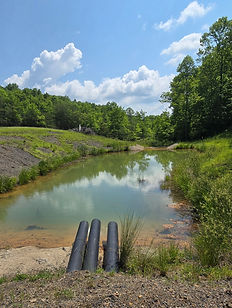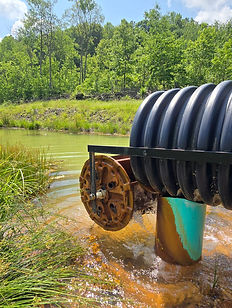
Saving Our Rivers and Streams for Future Generations
Together We Can Make a Difference

Roaring Creek District
North Portal Project

Roaring Creek, part of the Tygart Valley River watershed, is located in Randolph County, WV. Abandoned coal mining sites that date back to the 1930s produce varying amounts of Acid Min Drainage (AMD) that has caused the degradation of the lower section of Roaring Creek (below Coalton, WV) and its inclusion on the state’s 303(d) list. The Mars Portals sites on Roaring Creek, consist of a draining, open portal (Mars Portal 1), a collapsed portal (Mars Portal 2), and a portal that was reclaimed by the West Virginia Office of Abandoned Mine Lands and Reclamation (WVAML) with a wet seal (North Portal). These AMD sources are a major source of acidity and metals associated with a legacy of coal mining practices in the area. Save the Tygart Watershed Association (STTWA) partnered with the WV Water Research Institute’s (WVWRI) National Mine Land Reclamation Center (NMLRC) to accomplish the remediation of the North Portal. Penn Virginia, the landowners of the project site, joined in the partnership and agreed to not only provide access, but also engineering and design services for the project at no cost. In addition to this in-kind donation, NMLRC applied for and received WVDEP §319 funding for all three stages, and STTWA received an OSM WCAP grant to match NPS1704 and NPS1800, which funded the project in full. AllCon completed the construction for Phase I in September 2022, and additional limestone was added by Blue Ridge Construction under the direction of WVDEP-AML in September 2023. For Phase I of the project, WVDEP contributed $302,876 via §319(h) funds, OSMRE contributed $100,000 via the WCAP program, Penn Virginia provided a $60,000 match for engineering services and the STTWA provided in-kind in the amount of $15,561. The goal of phase I was to raise the pH and precipitate dissolved metals using treatment consisting of limestone beds, settling ponds, and an aeration wheel. Prior to treatment and based on research results from the 2012 Roaring Creek Watershed Based Plan, the North Portal contributed acidity loads of 105,200 lbs/yr, iron loads of 9,400 lbs/yr, aluminum loads of 6,400 lbs/yr, and manganese loads of 1,000 lbs/yr. The goals of this project were the removal of 84,160 lbs/yr of acidity, 7,520 lbs/yr of iron, 5,120 lbs/yr of aluminum, and 800 lbs/yr of manganese. Monthly post-construction sampling began in December of 2022 and concluded at the end of the project in August of 2023. Sampling results indicated that the system is substantially reducing the metal concentrations and the effluent is net alkaline. The system is still discharging an average of 349 lbs/yr of iron, 101 lbs/year of aluminum, and 169 lbs/yr of manganese into Roaring Creek; however, Phase II of the North Portal aims to facilitate further metal reductions. Projects are also slated for the Mars Portals to begin after completion of Phase II of the North Portal project.
North Portal Prior to Treatment Ponds

North Portal Project Today



